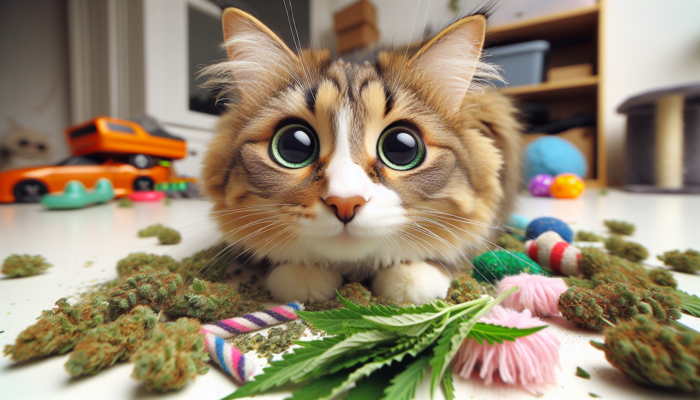Explore the Fascinating World of Catnip: Essential Insights and Information
Understanding the Unique Qualities of Catnip
To fully appreciate Catnip, scientifically known as Nepeta cataria, it’s important to delve into its remarkable characteristics. This resilient perennial herb, part of the mint family, originates from the rich landscapes of Europe and Asia, yet has seamlessly integrated into gardens and homes worldwide. With its serrated green leaves and delightful white flowers, Catnip may seem humble, but it boasts extraordinary properties that can bring immense joy to our furry friends, making it a must-have for any devoted cat lover.
The captivating charm of catnip primarily stems from its essential oil, particularly the compound known as nepetalactone. When cats interact with catnip—through sniffing, licking, or chewing—the compound binds to their olfactory receptors, triggering a series of neurological responses. This intriguing interaction often leads to exuberant behaviors, including rolling, purring, and playful antics, leaving even the most reserved observers amused, highlighting the herb's enchanting ability to captivate.
What about the plant itself? Catnip thrives in sunny environments and showcases impressive resilience. Unlike many delicate plants, it adapts well to a variety of soil types and growing conditions, making it a favored choice among both gardeners and cat enthusiasts. The leaves can be harvested and dried, preserving the herb's potent qualities for various cat-related products, ensuring that the joy of catnip is accessible year-round.
Investigating the Science Behind Catnip’s Enchanting Effects
The science behind catnip’s effects is both fascinating and complex. When cats come into contact with catnip, the nepetalactone attaches to specific receptors in their nasal tissue, sending signals to the brain’s olfactory bulb. This interaction stimulates sensory neurons, unveiling the euphoric behaviors commonly observed in cats. It's not merely a fleeting thrill; the effects can simulate a temporary state of feline intoxication, captivating both cats and their human companions alike.
Research indicates that roughly 50-75% of cats exhibit a response to catnip, with this sensitivity being largely genetic. Kittens and senior cats typically show minimal to no reaction, as their receptors might still be developing or may have diminished sensitivity due to age. Usually, when a cat engages with catnip, they experience excitement lasting around 10 to 15 minutes before they lose interest, showcasing a fascinating cycle of stimulation followed by relaxation.
Interestingly, catnip poses no threat or risk of addiction for our feline friends. The effects are short-lived, and once the initial excitement subsides, cats generally revert to their typical behavior. This cycle of engagement underscores the profound impact a simple herb can have on feline demeanor, making it a topic of interest for both pet owners and scientific communities.
Discovering Catnip’s Rich Historical Context and Uses
Exploring the historical significance of catnip unveils a rich tapestry woven through diverse cultures. Historically, catnip not only provided entertainment for cats but also served various functions for humans. The ancient Egyptians held this herb in high regard, using it for its psychoactive effects on felines, whom they considered sacred beings. They believed that the euphoric responses induced by catnip were divine gifts, linking cats to the gods.
In medieval Europe, catnip was embraced as a herbal remedy, brewed into calming teas believed to alleviate issues like insomnia, anxiety, and digestive problems. Herbalists recognized its soothing properties, which are still valued today in various natural medicine practices, bridging the gap between historical and contemporary uses.
The legacy of catnip extends further; in some cultures, it was utilized as a mild sedative, highlighting its versatility. Even now, it remains a cherished herbal remedy, often found in teas and tinctures, solidifying its reputation as a herb that transcends its playful connection with cats.
Gaining insight into the historical context of catnip deepens our appreciation for this remarkable herb, emphasizing its dual significance as a source of joy for our feline companions and a beneficial plant for human use.
Observing Catnip: Intriguing Feline Behaviors and Reactions

Analyzing the Unique Responses of Cats to Catnip
When discussing the <a href=”https://unitypets.com/catnip-in-australia-a-comprehensive-guide-for-cat-enthusiasts/”>catnip experience</a>, the reactions from cats can vary widely among individuals. The behaviors prompted by catnip can differ significantly from one feline to another. For some cats, it ignites a thrilling burst of energy—a wild sprint across the room, reminiscent of chasing unseen prey. Others may respond with gentle swaying, blissful rolling, or soothing purring that can last for several minutes.
The effects of catnip typically become apparent within seconds of exposure, prompting cats to engage in delightful activities such as rubbing their faces against the catnip, rolling joyfully, and vocalizing with enthusiasm. This scene epitomizes pure feline ecstasy. Conversely, some cats may prefer a more laid-back approach, relishing the scent while lounging in peaceful bliss.
Interestingly, the intensity of these reactions often hinges on the freshness of the catnip. Dried catnip tends to lose potency over time, and the fresher the leaves, the more likely they are to trigger a robust response. Additionally, the duration and intensity of the ‘high’ can vary greatly among cats, with many returning for more once they have had a chance to rest and rejuvenate.
For cat owners, understanding their pets' reactions to catnip is essential for crafting an enriching environment. Whether through toys infused with catnip or sprinkled on scratching posts, the key lies in observing your cat's preferences and tailoring their experience accordingly.
Comprehending the Duration and Frequency of Catnip Usage
When navigating the world of catnip, moderation is crucial. The duration of effects typically spans from 10 to 15 minutes, after which many cats will lose interest, often requiring a break before they can fully enjoy it again. This characteristic makes catnip an excellent tool for playtime without overwhelming your furry companion, facilitating delightful interactions.
As for frequency, it's advisable to wait at least a few hours between sessions. Overexposure could dull a cat's response, similar to any enjoyable experience. However, some cats may thrive on more frequent doses, making it essential to monitor your cat’s unique behaviors and adapt accordingly.
Introducing catnip into your cat’s routine should be done thoughtfully. Incorporating it into playtime can serve as a stimulant that encourages exercise and mental engagement. Whether you sprinkle it on their favorite toy or provide a new catnip-infused scratching post, the key is to keep the experience fresh and exciting, ensuring that your cat continues to find joy in this delightful herb.
By maintaining a balanced approach to catnip usage, you can ensure that your cat remains fascinated by this enchanting herb, using it as a source of stimulation and amusement rather than allowing it to become a mundane aspect of their routine.
Recognizing That Not Every Cat Responds to Catnip

One of the most intriguing aspects of catnip is its varied effects on different cats, a phenomenon largely attributed to genetics. Research indicates that sensitivity to catnip is hereditary, with approximately 50-75% of cats displaying some level of reaction. Kittens under six months and older cats often show little to no interest, as their receptors may not yet be developed or may have declined with age.
For those feline companions who remain indifferent to catnip, there's no need for concern! Numerous alternatives exist to stimulate your cat’s playfulness and curiosity. Options such as silvervine, valerian root, or even honeysuckle can evoke similar reactions, opening new avenues for fun and enrichment that can enhance your cat's life.
Moreover, some cats may simply lack the receptors that respond to nepetalactone, rendering them unaffected by the effects of catnip. Understanding this can help cat owners appreciate the individuality of their pets, ensuring that playtime remains enjoyable regardless of their reaction to this beloved herb.
Incorporating alternative stimulants into your cat’s routine can enrich their environment, ensuring that every cat, regardless of their response to catnip, discovers joy and excitement in playtime.
Incorporating Catnip into Everyday Life: Practical Tips
Using Catnip as a Training Tool for Your Feline Friend
Leveraging the delightful effects of catnip for training purposes can significantly enhance your bond with your feline companion. This herb can serve as a positive reinforcement tool, encouraging desirable behaviors while making the training process enjoyable for both you and your cat.
When introducing catnip into training sessions, it’s important to apply it thoughtfully. For example, if you want to motivate your cat to use a scratching post instead of your furniture, sprinkling some catnip on the post can entice them, transforming it into a more appealing option. This approach effectively redirects behaviors, promoting healthy habits while protecting your home furnishings.
The key is to consistently associate catnip with commands or actions. For instance, if you’re teaching your cat to come when called, rewarding them with a little catnip after they respond can reinforce the connection between the command and the pleasurable experience of catnip, strengthening their learning process.
Additionally, incorporating catnip during playtime can foster positive associations. Engaging your cat with catnip-infused toys not only stimulates their mind but also strengthens your bond, creating a fun and interactive environment that enhances the training experience.
Delving into the Variety of Catnip Toys and Products
The market for catnip toys and products is brimming with creativity, presenting a wide array of options to delight your feline friend. From plush toys to scratching posts infused with catnip, there's something for every cat's preferences.
Investing in high-quality catnip products can significantly enhance your cat’s playtime experience. Look for toys filled with organic catnip, ensuring they are free from harmful chemicals and additives. Reputable brands prioritize quality, often utilizing fresh catnip, which can markedly boost your cat’s engagement and enjoyment.
Interactive toys, such as feather wands infused with catnip or puzzle feeders that dispense catnip, offer both mental stimulation and physical exercise. These products not only entertain your cat but also encourage a healthy lifestyle, reducing the likelihood of boredom-related behaviors that can lead to destructive tendencies.
Moreover, don't overlook the joy of crafting DIY catnip toys. A simple project like filling an old sock with catnip and sewing it shut can create a delightful, homemade toy that your cat will adore. The joy of play is significantly amplified when catnip is involved, making it a vital addition to any cat parent’s toolkit.
Creating Your Own Catnip Garden for Endless Enjoyment
Establishing a catnip garden can be a rewarding endeavor for cat lovers and their feline companions alike. Not only does it provide fresh catnip for your cats, but it also beautifies your outdoor space, cultivating a vibrant and enjoyable environment.
Growing catnip is relatively simple, as it thrives in various conditions. It prefers well-drained soil and plenty of sunlight, so choosing a sunny spot in your garden is essential. Once planted, catnip requires minimal maintenance, making it an ideal option for busy gardeners who still wish to enhance their cats' experiences.
The advantages of cultivating your own catnip extend beyond aesthetics. Fresh catnip can be harvested and dried for use in toys, treats, or simply as a delightful experience for your cat to sniff. This not only saves money but also ensures that your cats indulge in high-quality, organic catnip free from pesticides and chemicals, promoting their health and wellbeing.
Furthermore, a catnip garden can serve as a sensory haven for your cat. Allowing them to explore their natural environment can stimulate their senses and provide enriching outdoor experiences. Just be sure to supervise your cat while they’re outside, ensuring their safety in the garden as they relish this delightful herb.
Health and Safety: Essential Guidelines for Catnip Usage
Evaluating the Safety of Catnip for Cats
When considering the safety of catnip, it’s crucial to determine whether this herb is safe for our feline companions. The straightforward answer is yes—catnip is generally safe for cats. It is non-toxic and can be enjoyed in moderation without adverse effects.
However, moderation is key. Excessive amounts of catnip may lead to mild gastrointestinal upset in some cats, resulting in symptoms such as vomiting or diarrhea. It’s essential to monitor your cat’s reactions and adjust the frequency of exposure as needed to ensure their wellbeing.
For kittens and young cats, it is advisable to wait until they reach at least six months of age before introducing catnip. Their sensory systems are still developing, and early exposure may not yield noticeable effects. By waiting, you can ensure a more enriching experience when they are ready to enjoy it.
In conclusion, catnip can be a delightful enhancement to your cat’s life, providing stimulation and joy. As long as you monitor their reactions and introduce it at the appropriate age, catnip can become a safe and enjoyable aspect of your pet’s daily routine.
Recognizing Signs of Catnip Overindulgence
Being aware of the signs of potential catnip overdose is crucial for any cat owner. While it’s uncommon for cats to overindulge to a dangerous extent, recognizing the symptoms can help ensure your pet’s wellbeing.
Signs of overexposure may include excessive drooling, vomiting, or lethargy. If your cat exhibits any of these symptoms following a session with catnip, it’s recommended to remove the catnip and monitor them closely. In most cases, the effects will diminish over time, and your cat will return to their usual behavior.
If symptoms persist or worsen, consulting your veterinarian is the best course of action. They can provide valuable advice and assistance to ensure your cat remains healthy and happy, addressing any concerns you may have.
As a preventive measure, always limit catnip sessions to a few times a day and allow breaks to avoid overstimulation. This strategy not only keeps your cat safe but also preserves the delightful effects of catnip, ensuring it remains a cherished treat.
Introducing Catnip to Kittens Responsibly and Effectively
When introducing catnip to young cats, a thoughtful approach is essential. Given that kittens under six months old often do not possess the receptors necessary to respond to catnip, it’s wise to delay exposure until they are older.
Once your kitten reaches the appropriate age, you can gradually introduce catnip. Start with small amounts and observe their reactions. Some kittens may exhibit curiosity and playfulness, while others might remain indifferent, which is completely normal.
If your kitten shows interest, incorporating catnip into their toys or playtime can be an exciting way to engage them and provide mental stimulation. However, if they show no reaction, that’s perfectly acceptable—there are plenty of other toys and activities that can keep them entertained without the need for catnip.
Ultimately, the key to introducing catnip to kittens is patience and observation. Every cat is unique, and their response to catnip can vary. Embrace their individuality and discover what works best for your furry friend to ensure a joyful experience.
Beyond Cats: Discovering Alternative Uses for Catnip
Exploring Catnip’s Potential Health Benefits for Humans
While catnip is primarily celebrated for its effects on felines, it also possesses potential benefits for humans. Historically, catnip has been used in herbal medicine for its calming properties. Brewed as a tea, it is believed to alleviate stress, anxiety, and even insomnia, making it a gentle natural remedy for those seeking relaxation.
The calming effects of catnip can be attributed to its mild sedative properties. Some studies suggest that it may assist in reducing anxiety and promoting restful sleep. However, it’s important to recognize that the potency of these effects may vary among individuals, and personal experiences can differ.
Incorporating catnip into your wellness routine can be as simple as brewing a soothing cup of catnip tea before bedtime. As with any herbal remedy, consulting with a healthcare professional prior to introduction into your regimen—especially for pregnant individuals or those taking medications—is advisable, ensuring safety and efficacy.
This lesser-known aspect of catnip adds another layer of appreciation for this versatile herb, illustrating its potential to benefit not just our feline companions but also humans in need of relief.
Utilizing Catnip as a Natural Pest Deterrent
In addition to its appeal for cats, catnip also plays a role in natural pest control. The essential oils found in catnip contain compounds that can deter various pests, including mosquitoes and cockroaches, making it a valuable ally in your home garden.
Using catnip as a natural pest repellent provides an eco-friendly alternative to chemical solutions. You can create a simple spray by steeping dried catnip in water and using it to mist areas prone to insects, which can be particularly beneficial in gardens where a natural deterrent can safeguard your plants without harming the environment.
Moreover, some studies have suggested that catnip might be more effective than DEET, the active ingredient in many commercial insect repellents. This makes it an attractive option for those looking to minimize their reliance on synthetic chemicals, promoting a healthier living space.
Incorporating catnip into your gardening practices not only benefits your cats but also creates a healthier, more sustainable environment for your home and outdoor spaces, allowing you to enjoy nature without harmful side effects.
Integrating Catnip into Culinary Creations
The culinary world has started to embrace catnip, showcasing its versatility beyond its attraction to our furry friends. While it may not be a staple in mainstream cooking, catnip can add a unique flavor profile to a variety of dishes.
In addition to its role in teas, catnip can be incorporated into














